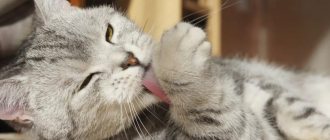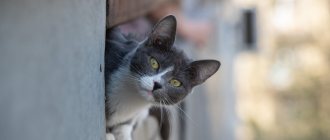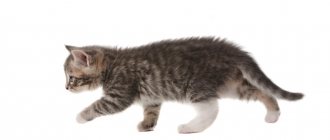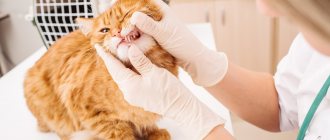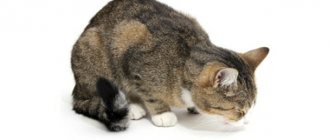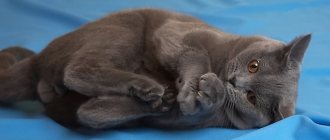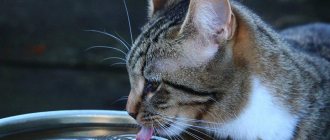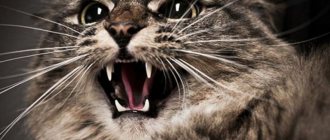Cats are clean and beautiful creatures. They constantly lick their own fur all over their body, spending up to 10% of their waking time doing this activity. By washing, cats solve several problems simultaneously:
- Cleansing from dust and foreign aromas that are absorbed into the hairs.
- Thermoregulation - moistened skin, cleared of excess lubricant, breathes better.
- Relieving anxiety - massage and fingering of its own fur calms the animal.
The cat's intestines are clogged with fur. We do the operation and get the wool
The rough tongue of cats is designed to comb hairs, collecting foreign microparticles. And the cat’s immune system can easily cope with the digestion of the minimum amount of dirt that enters the body during licking.
The difficulty can be the wool. The dead hairs, pulled into the mouth by the tongue, are swallowed by the cat. Under normal conditions, they are excreted from the body simultaneously with stool. Sometimes, 1-4 times a month, a cat may regurgitate hairballs. This happens if undigested fiber accumulates in the pet’s body. In most cases, the cat regurgitates cylindrical pellets along with mucus and sometimes food residue. This kind of phenomenon is completely good.
Sometimes a cat cannot regurgitate its fur. You may notice her opening her mouth, coughing, gagging, trying to help herself with her paws, but nothing else happens. Alarming symptoms may include:
- refusal of food;
- lethargy or restless restless behavior;
- dry spasmodic cough;
- hardening of the abdomen;
- dry, unkempt coat, refusal to wash;
- temperature increase;
- increased regurgitation of small hairballs;
- noticeable wool fibers in the stool.
Causes
Natural causes look pretty harmless:
After prolonged fasting, a response from the cat's body may be observed in the form of contraction of muscle tissue, manifested as the urge to vomit, but the eruption of vomit does not occur.
When overeating, the stomach tries to free itself from overload and throw away excess food. Contractions of the muscles of the stomach and esophagus begin, but vomiting does not occur.
Cats constantly clean themselves of fur and wash themselves. At the same time, when it gets inside, it can form into hard lumps, then help is required.
The cause of the urge may be the entry of foreign small objects into the mouth: threads, hair, grass. In such cases, the cat helps itself.
If symptoms persist, you should contact your veterinarian.
Vomiting also occurs after visiting veterinary offices or medical intervention. It is not dangerous and the symptoms go away after a while.
It is useful to have special veterinary medications in your home medicine cabinet to free the gastrointestinal tract from irritants.
Recommended items for a home first aid kit:
- anthelmintic drugs: Cestal cat, Dirofen, Milbemax;
- sedatives: Fospasim, Bach drops;
- immune system stimulants: Catozal, Gamavit, Evinton;
- for injuries: Travmatin, Monklavit;
- before and after childbirth: Mastomethrin, calcium borogluconate, Oxytocin;
- for constipation and diarrhea: Bifitrilak, Veracol, Linex;
- Iris eye drops.
Types of dysphagia
This disorder in cats can be classified according to several criteria.
For example, according to the principle of anatomical and functional disorders:
- anatomical defects that impede the passage of food and liquid, and they can be congenital or acquired;
- functional problems that are determined by a motor disorder of the swallowing process.
Highlight:
- oral;
- pharyngeal or pharyngeal;
- and esophageal swallowing disorder.
With an oral swallowing disorder, the animal is unable to grasp food and form the usual food bolus at the base of the tongue. Food accumulates in the folds of the animal's oral mucosa. The cat chews the piece placed in its mouth for too long, shakes its head and throws it up, thus trying to move the food bolus. Crusts form on the animal's face, but there is no vomiting, and adaptive behavior allows the pet to at least somehow eat.
Swallowing is a reflex act; if, when the root of the tongue is irritated by a food bolus, this reflex is not excited, then attempts to swallow food cause a gag reflex, the food bolus returns to the oral cavity or enters the animal’s nose. This type of dysphagia is called pharyngeal dysphagia. There are several types of this disorder:
- impaired contraction of the muscles of the pharyngeal ring;
- pathology of pharyngeal closure;
- lack of opening of a special valve (esophageal sphincter) formed by the cricopharyngeal and cricopharyngeal muscles.
With this disorder, the animal regurgitates a bolus of food (even several hours after trying to eat). A cat with this disorder loses weight because it is unable to move food even with the help of adaptive behavior.
With esophageal disorder, the animal can push the bolus of food into the esophagus, but after a while vomiting occurs. The cat is coughing and regurgitating food. Such an animal quickly loses weight and becomes dehydrated.
How to help a cat
The appearance of intense retching without vomiting indicates that the animal has formed a ball of fur of considerable size. A special paste from the first aid kit will relieve the cat from the painful condition. The contents of the tube are mixed with the food, or you can feed directly from the tube.
Cats can cleanse their bodies on their own by using grass outside. Sometimes they try to eat indoor plants. After herbal therapy, gastric bowel movements are induced and the body's functioning is restored.
What is wrong with a cat who is vomiting white foam?
- Poisoning – if the cat vomits white foam after eating.
- Post-operative period – the cat vomits because the body is trying to recover.
- Viruses (herpetic, corona virus, rabies, panleukopenia, etc.) – white foam, diarrhea, weakness, high temperature, the cat may be vomiting blood.
- Diseases of the digestive system (gastritis, etc.) - the cat vomits bile, foam and blood.
- Worms - molting, indigestion, weakness, vomiting white foam and even with larvae.
What kind of cabbage soup does a cat not regurgitate hair from?
If the cat is okay with its appetite and activity, but you don’t see your beloved spitting up fur, there is no reason to worry. A strong organization in conditions of proper nutrition copes with the removal of hair during bowel movements.
If a cat usually sheds fur, but has stopped, think about whether something has changed in its diet. If you have not transferred it, get special supplements, there is a reason to monitor the animal, I think it cannot regurgitate its fur.
When a cat tries but cannot push out a hairball, it may have become too large or stuck.
Recommended products for treating and removing hair
Cliny paste has good reviews
. The composition includes malt extract, corn oil, vegetable fiber, whole milk powder, distilled water with silver ions, potassium sorbate. It is acceptable to use both adult cats and kittens for therapeutic and preventive purposes. Eliminates constipation, vomiting, improves digestion, increases appetite.
Cliny toothpaste is suitable for kittens and adult cats.
Beaphar Bits Mix
Beaphar Bits Mix pads are a treat for pets. Brown Malt Bits pads contain malt paste to cleanse the digestive system.
. Used for prophylactic use. Green Catnip Bits contain catnip.
What to do to help your cat
The basics that are needed are:
- Regular brushing, especially of long-haired breeds with thick undercoat. Train your sim once a week, and during the molting period - every day or two.
- Choose the right food for your cat. It includes a healthy diet with minerals for normal coat growth, and in turn nutritional supplements with enzymes and fibers that help the pet's body break down stubborn debris, including hair. Such additives are malt-tomato and dry malt-bit pads.
- If you have severe symptoms, contact your veterinarian.
Prevention
Regular combing. The more dead hairs on the comb or brush, the less will be in the cat’s stomach. This procedure should become regular - about once a week, and during molting - daily.
Include fiber in your cat's diet, such as boiled vegetables.
Professional food - a special formula for hair removal with a high content of plant fibers provides a complete, balanced diet and helps the natural removal of hair from the body. The food can be given separately or mixed with daily food.
Hair removal paste - contains malt syrup, mineral oil and lecithin, which have a positive effect on the digestive system.
Grass is a quick way to help your pet clear his stomach of hair (you can buy seeds and sprout them at home).
Water is necessary for digestion. To improve its daily consumption, you can purchase an automatic drinker with an aquafilter and a constant circulation mode. The water in such a device is always clean, fresh and cool.
Cats are clean and tidy creatures. They regularly lick their fur all over their body, spending up to 10% of their waking time doing this activity. By washing, cats solve several problems at once:
- Cleansing from dust and foreign odors that are absorbed into hairs.
- Thermoregulation - moistened skin, cleared of excess lubricant, breathes better.
- Relieving anxiety - massage and fingering of its fur calms the animal.
The rough tongue of cats is designed in such a way as to comb hairs, collecting foreign microparticles. And the cat’s immune system easily copes with digesting a small amount of dirt that enters the body when licking.
The problem may be the wool. The dead hairs, pulled into the mouth by the tongue, are swallowed by the cat. Under normal conditions, they are excreted from the body in the stool. Sometimes, 1-4 times a month, a cat may vomit hairballs. This happens if undigested fiber accumulates in the pet’s body. Usually the cat regurgitates cylindrical pellets along with mucus and sometimes food debris. This phenomenon is completely normal.
Sometimes a cat cannot regurgitate its fur. You may notice her opening her mouth, coughing, gagging, trying to help herself with her paws, but nothing else happens. Alarming symptoms may include:
- refusal of food;
- lethargy or restless, fidgety behavior;
- dry spasmodic cough;
- hardening of the abdomen;
- dry, unkempt coat, refusal to wash;
- temperature increase;
- increased regurgitation of small hairballs;
- noticeable wool fibers in the stool.
In honor of what holiday does a cat often lick itself? Prevention of the problem
- Unfavorable environment.
If the room is poorly cleaned, and the cat is accustomed to cleanliness, when it is often stroked, ruffling the fur and leaving common human sebum on it, if a new pet has appeared in the house with its own smell, this will force the cat to intensively maintain its own cleanliness. - Shedding.
During the round of seasonal coat change (in the spring, seals shed their winter fluff, and in the fall, on the contrary, they renew their fluff for the cold weather), the cat can get caught in the hairs, so he will want to get rid of them. - Heat.
If the room has high humidity and air temperature, the animal feels stuffy in its fur coat; by washing the pet tries to freshen up and facilitate skin respiration to reduce body temperature. - Worm infestation.
The activity of parasites causes the cat to experience discomfort. - Stress.
If the cat is scared or the room is noisy, the animal will calm itself by licking when entering a new environment.
So, to avoid trouble, try to help the animal and help normalize the situation. Keep the house clean, don’t force your pet to interact closely with other animals, and don’t let guests pet the cat if he doesn’t want to.
During shedding, brush the shoddy twice a day, depending on the breed. This period is short-lived. If there are a lot of hairs left on the brush, then they need to be removed. The cat is brushed when the brush remains clean. When the comb no longer accumulates a lot of hair in one procedure, the shedding is over. Regular brushing of your pet will help keep your home tidy and will also prevent hair from accumulating in your pet’s body.
Why is fur in a cat's stomach dangerous?
Hairballs remaining in the animal's stomach cause disease in the four-legged animal. Most hairs accumulate in a cat's stomach during shedding. In order not to harm the health of your pet, you need to know how to help a cat remove hair from its stomach, avoiding undesirable consequences: - hair balls accumulated inside the cat’s stomach lead to disruption of the digestive process; hairballs cause the animal to feel a full stomach; at the same time, the pet consumes a smaller portion of food and does not receive the nutrients it needs; - Rolled hair balls can cause intestinal obstruction in a cat; and when the owner of the animal is faced with the question of how to remove hairballs from the cat’s stomach, he has to solve it in a veterinary clinic and often through surgery; - in long-haired cats, hairs often accumulate below the jaws behind the fangs and penetrate into the gums, causing inflammation; this hair should be removed since the animal cannot remove it on its own.
It happens that a pet independently gets rid of hairballs inside its stomach by regurgitating them. This is a natural process. Therefore, the animal should not be scolded. To understand that a cat has problems associated with the presence of hair in the stomach, you just need to carefully observe it.
Video: how to deal with shedding in cats?
It's easy and interesting to communicate here. Join us!
very good medicine in a tube (photo) cats love it very much, they can lick it directly from the tube, slowly squeeze it out and the cats lick it off themselves, I usually give it to mine once a week, I squeeze out two cm at a time. You can give it to yours more often, you’ll see for yourself, wool will come out naturally, belching will be a thing of the past and he will be very grateful to you.
change the food, my cat is on homemade food and has not burped in 2 years
There is a special paste. buy it at a veterinary clinic! And also plant some grass for the cat. helps too! This is how mine chews it!
Why did you decide that a cat cannot vomit fur? He's vomiting bile. . Take him to the vet and have his liver and pancreas checked. . And Hills is not a panacea... Or rather, it is not a guarantee that nothing will happen. . And what you need from wool is not food, but grass or malt paste.
Have you tried giving grass to a cat, the kind in pots sold in pet stores? usually with the help of it they regurgitate the fur; in general, this is why the animal gnaws it
There are vitamins for dissolving hair, although I don’t believe it, it will probably just go out through the anus. Grass theme my 2 cats 4 of them can sit at a time)
Maybe the vomiting is not due to the presence of hair in the stomach? Moreover, you are giving medications to dissolve fur. Could there be a foreign object in the respiratory tract? Better show it to the vet.
Differences between vomiting and regurgitation
If immediately after regurgitation the cat behaves calmly and naturally, there is nothing to worry about, this is not vomiting as such. You can distinguish vomiting from regurgitation of hair or food by the following signs:
- the process is painless, not painful;
- general condition does not worsen, there are no signs of disease;
- The cat sometimes provokes regurgitation itself as needed.
Unlike regurgitation, vomiting is accompanied by more alarming manifestations both in the state of the animal’s health and in the way this rejected mass looks:
- Thick, dark brown vomit can be caused by a tumor, ulcer, foreign object, kidney failure, or gastrointestinal disease.
- Bright scarlet inclusions indicate bleeding in the esophagus or mouth.
- White foam. It is not dangerous if done once (means that the cat ate on an empty stomach, and as a result, gastric juice, air and mucus were released). It's a bad symptom if it happens often.
- Yellow vomit indicates bile entering the stomach and irritating its mucous membrane, problems with the liver, intestines, or the cat has eaten too many eggs.
- Frequent vomiting of undigested food – problems with the intestines, gall bladder, and liver. Intestinal obstruction or infection is possible.
- Yellow-gray mass - it’s time to change industrial food.
- Green vomit is possible with severe infections or bile or intestinal contents entering the stomach. Not to be confused with regurgitation, when the green color is caused by the cat eating grass.
- Mucus impurities indicate gastritis, helminthic infestations (if there is mucus in the stool), and viral intestinal diseases.
- Vomits like a fountain when the gastrointestinal tract is completely blocked (foreign body, ICP, encephalitis, blood clots, narrowing of the canal, large accumulations of hairballs inside that were not removed in time), when under internal pressure the vomit is pushed out unexpectedly and over a long distance.
These are already very serious signs in which an emergency visit to the veterinarian can be truly vital for the pet.
